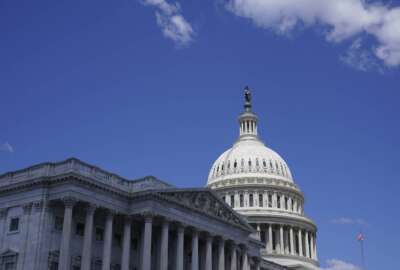
Two agencies took initial steps to implement Schedule F, GAO finds
Although never fully implemented, a new GAO report reveals two agencies that started initial steps of reclassifying positions to Schedule F.
Although the Office of Personnel Management never officially moved any federal employee to Schedule F when the executive order was at its peak, a couple agencies took initial steps toward reclassifying parts of their workforce.
Near the end of the Trump administration, the Office of Management and Budget planned to shift 136 of its positions into a Schedule F classification — a request which OPM was able to approve before President Joe Biden revoked the order during his first week in office.
OMB never actually changed over any of its positions, but if the reclassification had been completed, the agency’s efforts would have resulted in 415 feds, or approximately 68% of its workforce, to become at-will workers, a Sept. 28 report from the Government Accountability Office found. Around 87% of the OMB employees initially approved for Schedule F reclassification were at the GS-13 level or above.
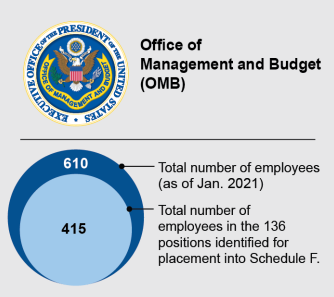
The Trump-era executive order on Schedule F created a new federal job classification, which, if agencies had fully implemented it, would have moved roughly 50,000 policy-related positions to the new schedule. The Trump administration said the intention of Schedule F was to add flexibility to the federal workforce and make it easier to remove poor-performing workers. Many federal unions, employee organizations and others strongly condemned it, saying it would remove civil service protections for those employees.
The order was short-lived, meaning no agencies were actually able to implement it. But OMB was far ahead of many others in taking steps toward realizing the executive order, largely because the former OMB director had instructed the agency to lead the overall federal response, OMB officials reported to GAO.
Alongside OMB, the U.S. International Boundary and Water Commission also submitted a request to OPM to change five of its workforce positions to Schedule F. But Biden revoked the order before OPM completed the review process.
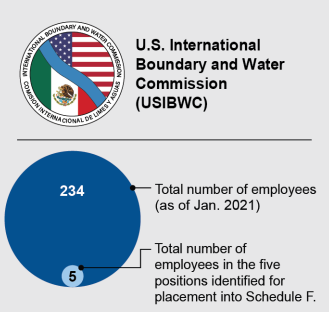
Officials at USIBWC told GAO that the expedited hiring Schedule F provided could help the agency when competing for job candidates, particularly at its remote border offices where recruitment and retention are particularly difficult. Officials also noted the agency’s desire to have employees the commissioner “trusted to expeditiously carry out policy decisions,” GAO wrote.
Finally, agency officials saw positives in Schedule F’s “flexibility to quickly remove poorly performing employees rather than wait for them to retire, leave or go through the removal process, which they said was lengthy,” GAO wrote.
Although OMB and the USIBWC were the two agencies to move furthest along in the reclassification process, thirteen other agencies were also communicating with OPM about their ability to implement the Schedule F executive order, GAO found.
Of those thirteen agencies, seven said they would need more time to figure out the reclassification process, and the other six told OPM they would not request positions be placed into Schedule F.
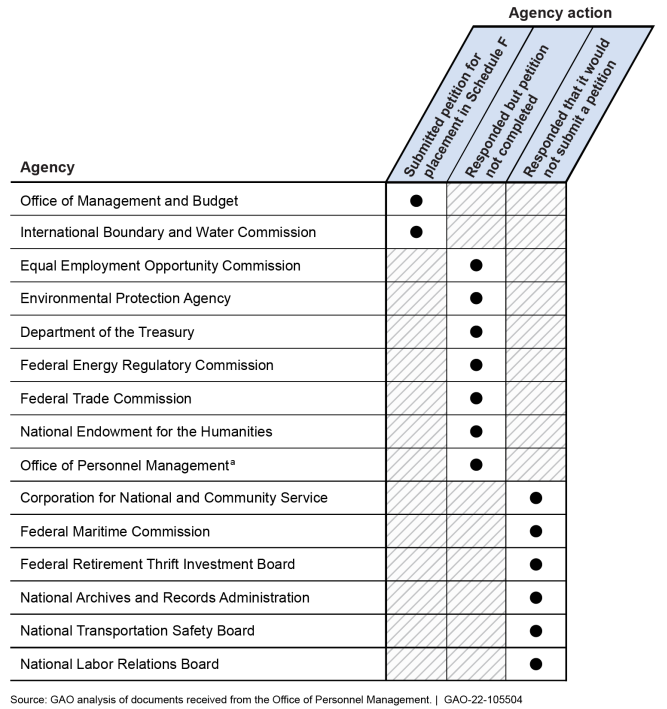
But OPM did not issue any Schedule F-related regulations before Biden revoked the executive order.
“OPM officials told us they wanted to observe how agencies implemented Schedule F,” GAO wrote. “This would allow them to understand the common issues agencies faced in implementation before issuing regulations.”
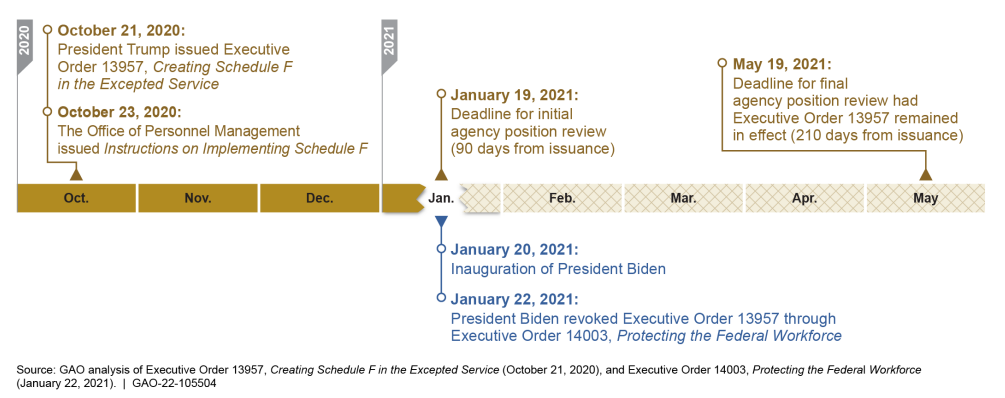
Current leaders at both OPM and OMB expressed strong disapproval of Schedule F-related policy. OMB Director Shalanda Young, along with OPM Director Kiran Ahuja, wrote in a letter to GAO that the Trump-era policy hinged on “false and harmful assumptions” about the effectiveness of the career civil service.
“The members of our career workforces provide critical expertise, continuity and stability in helping our agencies and the entire federal government meet the needs of the American people,” the directors wrote in a Sept. 19 letter. “It is essential that our career employees remain empowered to execute our important missions, free from political interference or intimidation.”
Although none of the agencies ever implemented the executive order during its existence, some stakeholders that GAO interviewed for the report said a potential revival of the executive order could still be on the table in a future administration.
But the group of stakeholders GAO interviewed, comprising former agency officials, academics, federal union officials and nonprofit employees, differed in how they felt about Schedule F. Some said the classification could expedite an administration’s ability to hire more politically aligned federal employees, while removing crucial merit systems protections. Others, though, said it would help create more hiring flexibilities and remove poor performers at agencies.
Some stakeholders shared further concerns about Schedule F’s impact on federal recruitment and retention. They discussed the potential for applicants to turn down a position in Schedule F, as taking the job might put them at risk of later being removed “for partisan political reasons,” GAO wrote.
And members of Congress are raising the alarms about Schedule F, too. The House recently passed legislation, titled the Preventing a Patronage System Act, aiming to prevent any future administration from creating a new federal job classification, which would effectively remove the potential for a return of Schedule F-type policy. The bill cleared the House mostly along party lines, but six Republicans voted in favor of it. The Senate introduced a companion bill, but the legislation has not moved forward for a vote.
In contrast, many Republicans in Congress expressed their support for Schedule F. Former President Trump has also said he would revive the policy if he was reelected, though his 2024 presidential campaign is not yet official.
Despite their differences, the stakeholders that GAO interviewed did have one thing in common: most said the speed of federal hiring needs to be improved. Some groups, like the Partnership for Public Service, further elaborated on the need for workforce reforms, while also denouncing Schedule F.
“Instead of undermining and politicizing the career federal workforce, the focus should be on improving our system by reducing the number of political appointees and streamlining the nomination and confirmation process, improving leadership development, placing greater emphasis on employee recognition, supporting innovation, increasing accountability for poor performers, streamlining hiring practices and bringing more young people into government,” the Partnership’s President and CEO Max Stier said.
Copyright © 2024 Federal News Network. All rights reserved. This website is not intended for users located within the European Economic Area.
Drew Friedman is a workforce, pay and benefits reporter for Federal News Network.
Follow @dfriedmanWFED




